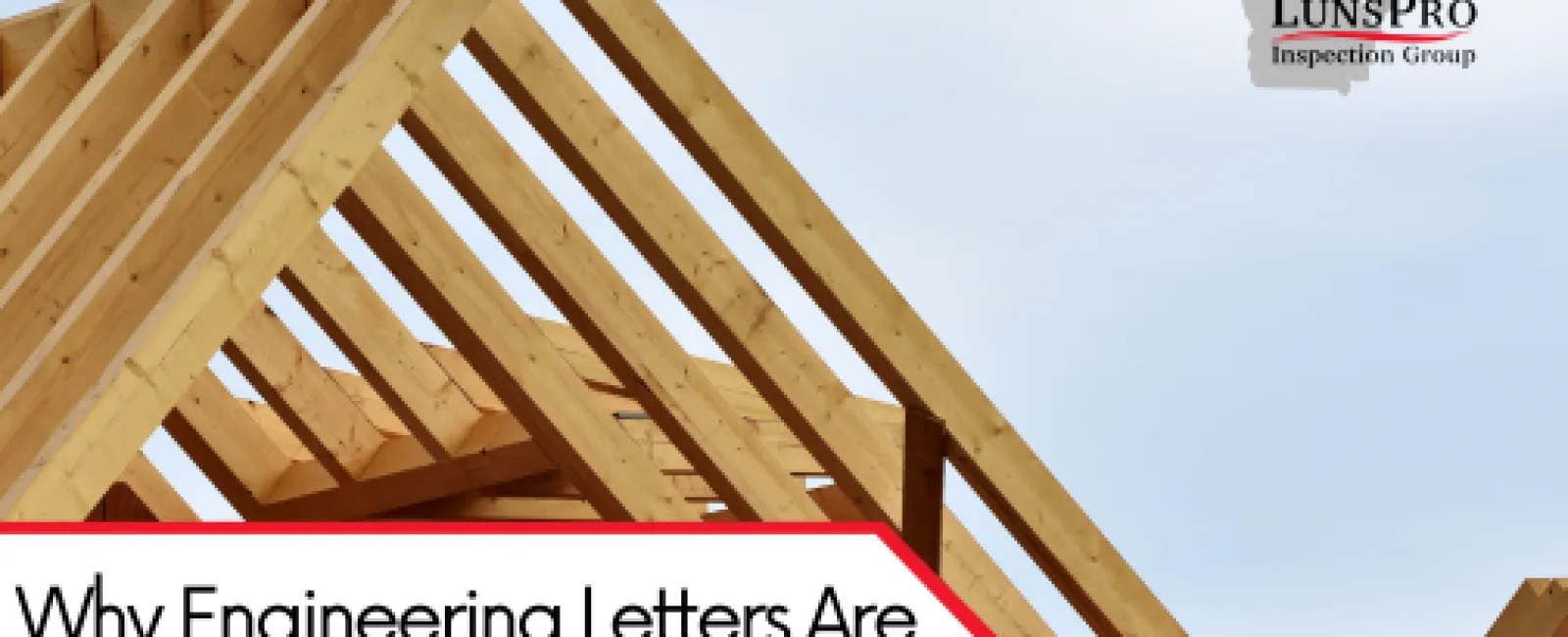When it comes to home inspections and property safety, few structural components are as important as the roof trusses. These engineered systems are designed to distribute weight evenly and support the integrity of the entire roof. However, when a truss is damaged—whether due to poor installation, water damage, or structural alterations—it can compromise the safety of the home. This is where the need for an engineering letter on truss repair becomes critical.
At LunsPro Inspection Group, we regularly encounter situations in which damaged or altered trusses raise concerns for buyers, sellers, and real estate professionals. In these cases, our inspectors, such as ASHI-Certified Inspector Britt B., emphasize the importance of proper documentation and approval from a licensed structural engineer. An engineering letter is more than just paperwork; it is a professional certification that the repair meets safety standards and complies with building codes. Understanding this process can make the difference between a smooth real estate transaction and significant setbacks.
What Are Roof Trusses and Why Do They Matter?
Roof trusses are pre-engineered wooden frameworks that form the backbone of a home's roofing system. Unlike traditional framing, trusses are designed for efficiency, strength, and precision. They distribute weight evenly across the walls and foundation, ensuring that the roof remains stable under various conditions, such as heavy rain, high winds, or snow loads.
Because trusses are engineered systems, even small modifications or damage can disrupt their structural integrity. A cut truss, for instance, might seem minor, but it can lead to sagging, roof leaks, or in severe cases, collapse. That is why inspectors take truss damage seriously and why homeowners should never attempt DIY repairs without professional oversight.
Common Causes of Truss Damage
Truss damage is more common than many homeowners realize. Some of the most frequent causes include:
-
Improper Alterations - Homeowners or contractors may cut into trusses to make space for ductwork, plumbing, or attic modifications. These changes weaken the system.
-
Water Intrusion - Roof leaks can compromise the wood's strength, leading to rot or mold growth.
-
Pest Activity - Termites, carpenter ants, and other wood-destroying pests can eat away at truss members.
-
Excessive Weight - Adding too much weight in the attic, such as storage boxes or HVAC equipment, can overload trusses.
-
Storm Damage - High winds or fallen trees can crack or displace truss components.
Recognizing these risks during an inspection is the first step in protecting the property and ensuring long-term stability.
Why Engineering Letters Are Required
When truss damage is identified, many lenders and buyers will require an engineering letter before moving forward with the transaction. This letter, issued by a licensed structural engineer, provides written confirmation that:
-
The repair has been properly designed and executed.
-
The truss system maintains its load-bearing capacity.
-
The home remains structurally sound and safe for occupancy.
Without an engineering letter, repairs may be deemed insufficient, potentially stalling the sale. More importantly, skipping this step could expose homeowners to liability if structural issues worsen after the transaction.
The Role of Inspectors in Identifying Truss Issues
Inspectors like Britt B. play a crucial role in detecting truss problems during home inspections. Using their training, experience, and tools such as drones and infrared cameras, they can spot signs of hidden damage or improper modifications. Once identified, the inspector documents the issue and advises the buyer, seller, or real estate agent to consult a structural engineer.
By bridging the gap between discovery and resolution, inspectors ensure that problems are addressed properly, reducing risk for all parties involved. At LunsPro Inspection Group, our emphasis is always on thoroughness and transparency, which helps maintain trust in every inspection report.
How Engineering Letters Protect Buyers and Sellers
For buyers, an engineering letter provides peace of mind that the home they are purchasing is safe and compliant. It ensures that the roof and foundation—two of the most important structural systems—are not compromised. This documentation also gives buyers leverage if negotiations are required, helping them avoid costly repairs after closing.
For sellers, obtaining an engineering letter can prevent last-minute obstacles that delay or derail a sale. It demonstrates responsibility and a commitment to providing a sound home, which can improve buyer confidence and speed up the closing process. In competitive real estate markets, this can make a significant difference.
The Process of Obtaining an Engineering Letter
Securing an engineering letter typically involves several steps:
-
Inspection Identification - The issue is flagged during the home inspection.
-
Referral to an Engineer - The homeowner or agent contacts a licensed structural engineer.
-
Engineer Assessment - The engineer evaluates the truss damage and specifies repair requirements.
-
Repair Completion - A qualified contractor performs the repair according to the engineer's plan.
-
Final Review and Documentation - The engineer inspects the repair and issues a letter verifying compliance.
This process may sound lengthy, but in practice, it can be completed efficiently when coordinated properly. The result is a legally recognized document that satisfies building codes, lenders, and real estate professionals.
Why Professional Oversight Matters
Attempting to repair a truss without professional oversight is risky. Not only can it create safety hazards, but it can also void insurance coverage and cause the home to fail future inspections. Engineering letters ensure that repairs are done to code, preserving both property value and homeowner safety.
Furthermore, many municipalities require permits for structural modifications, and an engineering letter may be part of that approval process. By working with inspectors and engineers, homeowners avoid legal complications while ensuring their property remains market-ready.
LunsPro's Commitment to Thorough and Trusted Inspections
At LunsPro Inspection Group, our mission is to provide buyers, sellers, and real estate agents with the confidence they need to move forward in real estate transactions. Our team understands the stress that comes with unexpected findings like truss damage, and we work to ensure that the process of resolving these issues is as smooth as possible.
By identifying problems early, explaining them clearly, and guiding clients toward proper resolutions, our inspectors help prevent small issues from becoming major obstacles. Whether it involves truss damage, foundation concerns, or other structural components, our inspections give clients the tools they need to protect their investment.
Roof trusses are a cornerstone of a home's structural system, and any damage to them should never be taken lightly. Engineering letters provide the necessary assurance that truss repairs meet the standards of safety, strength, and compliance. By requiring these letters, buyers, sellers, and lenders all benefit from a system that prioritizes long-term stability and peace of mind.
For homeowners and real estate professionals, working with LunsPro Inspection Group means gaining a trusted partner who understands the importance of these details. With experienced inspectors like Britt B., advanced technology, and a commitment to thorough evaluations, LunsPro helps ensure that every inspection supports safe, successful, and stress-free real estate transactions. Whether you are buying, selling, or maintaining your property, choosing a professional inspection is one of the best decisions you can make.

